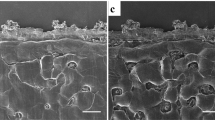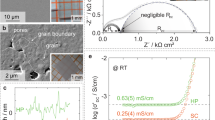Abstract
Failure caused by dendrite growth in high-energy-density, rechargeable batteries with lithium metal anodes has prevented their widespread use in applications ranging from consumer electronics to electric vehicles. Efforts to solve the lithium dendrite problem have focused on preventing the growth of protrusions from the anode surface. Synchrotron hard X-ray microtomography experiments on symmetric lithium–polymer–lithium cells cycled at 90 °C show that during the early stage of dendrite development, the bulk of the dendritic structure lies within the electrode, underneath the polymer/electrode interface. Furthermore, we observed crystalline impurities, present in the uncycled lithium anodes, at the base of the subsurface dendritic structures. The portion of the dendrite protruding into the electrolyte increases on cycling until it spans the electrolyte thickness, causing a short circuit. Contrary to conventional wisdom, it seems that preventing dendrite formation in polymer electrolytes depends on inhibiting the formation of subsurface structures in the lithium electrode.
This is a preview of subscription content, access via your institution
Access options
Subscribe to this journal
Receive 12 print issues and online access
$259.00 per year
only $21.58 per issue
Buy this article
- Purchase on Springer Link
- Instant access to full article PDF
Prices may be subject to local taxes which are calculated during checkout




Similar content being viewed by others
References
US Department of Energy Multi-Year Program Plan 2011–2015: Vehicle Technologies Program. (2010).
Tarascon, J. M. & Armand, M. Issues and challenges facing rechargeable lithium batteries. Nature 414, 359–367 (2001).
Yaws, C. L. Yaws’ Handbook of Properties of the Chemical Elements (Knovel, 2011).
Aurbach, D., Zinigrad, E., Cohen, Y. & Teller, H. A short review of failure mechanisms of lithium metal and lithiated graphite anodes in liquid electrolyte solutions. Solid State Ion. 148, 405–416 (2002).
Eweka, E., Owen, J. R. & Ritchie, A. Electrolytes and additives for high efficiency lithium cycling. J. Power Sources 65, 247–251 (1997).
Goodenough, J. B. & Kim, Y. Challenges for rechargeable Li batteries. Chem. Mater. 22, 587–603 (2010).
Kalnaus, S., Sabau, A. S., Tenhaeff, W. E., Dudney, N. J. & Daniel, C. Design of composite polymer electrolytes for Li ion batteries based on mechanical stability criteria. J. Power Sources 201, 280–287 (2012).
Tatsuma, T., Taguchi, M., Iwaku, M., Sotomura, T. & Oyama, N. Inhibition effects of polyacrylonitrile gel electrolytes on lithium dendrite formation. J. Electroanal. Chem. 472, 142–146 (1999).
Monroe, C. & Newman, J. Dendrite growth in lithium/polymer systems—A propagation model for liquid electrolytes under galvanostatic conditions. J. Electrochem. Soc. 150, A1377–A1384 (2003).
Mayers, M. Z., Kaminski, J. W. & Miller, T. F. Suppression of dendrite formation via pulse charging in rechargeable lithium metal batteries. J. Phys. Chem. C 116, 26214–26221 (2012).
Monroe, C. & Newman, J. The impact of elastic deformation on deposition kinetics at lithium/polymer interfaces. J. Electrochem. Soc. 152, A396–A404 (2005).
Gellings, P. J. & Bouwmeester, H. J. M. The CRC Handbook of Solid State Electrochemistry (CRC Press, 1997).
Bruce, P. G., Freunberger, S. A., Hardwick, L. J. & Tarascon, J. M. Li–O2 and Li–S batteries with high energy storage. Nature Mater. 11, 19–29 (2012).
Dunn, B., Kamath, H. & Tarascon, J. M. Electrical energy storage for the grid: A battery of choices. Science 334, 928–935 (2011).
Gireaud, L., Grugeon, S., Laruelle, S., Yrieix, B. & Tarascon, J. M. Lithium metal stripping/plating mechanisms studies: A metallurgical approach. Electrochem. Commun. 8, 1639–1649 (2006).
Brissot, C., Rosso, M., Chazalviel, J. N. & Lascaud, S. In situ concentration cartography in the neighborhood of dendrites growing in lithium/polymer-electrolyte/lithium cells. J. Electrochem. Soc. 146, 4393–4400 (1999).
Rosso, M. et al. Dendrite short-circuit and fuse effect on Li/polymer/Li cells. Electrochim. Acta 51, 5334–5340 (2006).
Stone, G. M. et al. Resolution of the modulus versus adhesion dilemma in solid polymer electrolytes for rechargeable lithium metal batteries. J. Electrochem. Soc. 159, A222–A227 (2012).
Liu, S. et al. Lithium dendrite formation in Li/poly(ethylene oxide)-lithium bis(trifluoromethanesulfonyl)imide and N-methyl-N-propylpiperidinium bis(trifluoromethanesulfonyl)imide/Li cells. J. Electrochem. Soc. 157, A1092–A1098 (2010).
Dolle, M., Sannier, L., Beaudoin, B., Trentin, M. & Tarascon, J. M. Live scanning electron microscope observations of dendritic growth in lithium/polymer cells. Electrochem. Solid State 5, A286–A289 (2002).
Bhattacharyya, R. et al. In situ NMR observation of the formation of metallic lithium microstructures in lithium batteries. Nature Mater. 9, 504–510 (2010).
Chandrashekar, S. et al. Li-7 MRI of Li batteries reveals location of microstructural lithium. Nature Mater. 11, 311–315 (2012).
Tatsuma, T., Taguchi, M. & Oyama, N. Inhibition effect of covalently cross-linked gel electrolytes on lithium dendrite formation. Electrochim. Acta 46, 1201–1205 (2001).
Lopez, C. M., Vaughey, J. T. & Dees, D. W. Morphological transitions on lithium metal anodes. J. Electrochem. Soc. 156, A726–A729 (2009).
Yoshimatsu, I., Hirai, T. & Yamaki, J. Lithium electrode morphology during cycling in lithium cells. J. Electrochem. Soc. 135, 2422–2427 (1988).
MacDowell, A. A. et al. X-ray micro-tomography at the Advanced Light Source. Proc. SPIE 8506, 850618 (2012).
Groso, A. et al. Phase contrast tomography: An alternative approach. Appl. Phys. Lett. 88, 214104 (2006).
Maia, F. R. N. C. et al. Compressive phase contrast tomography. Proc. SPIE 7800, 78000F (2010).
Lectro Max 100 Product Data Sheet; http://www.fmclithium.com/.
Frianeza-Kullberg, T. C. & Salmon, D. J. Removal of lithium nitride from lithium metal. US patent 4,781,756 (1988).
Brissot, C., Rosso, M., Chazalviel, J. N. & Lascaud, S. in Studies in Surface Science and Catalysis Vol. 132 (eds Oyama, N., Iwasawa, Y. & Hironobu, K.) 947–952 (Elsevier, 2001).
Rosso, M., Chassaing, E., Chazalviel, J. N. & Gobron, T. Onset of current-driven concentration instabilities in thin cell electrodeposition with small inter-electrode distance. Electrochim. Acta 47, 1267–1273 (2002).
Rosso, M., Gobron, T., Brissot, C., Chazalviel, J. N. & Lascaud, S. Onset of dendritic growth in lithium/polymer cells. J. Power Sources 97–98, 804–806 (2001).
Mullin, S. A., Stone, G. M., Panday, A. & Balsara, N. P. Salt diffusion coefficients in block copolymer electrolytes. J. Electrochem. Soc. 158, A619–A627 (2011).
Singh, M. et al. Effect of molecular weight on the mechanical and electrical properties of block copolymer electrolytes. Macromolecules 40, 4578–4585 (2007).
Bruce, P. G. & Vincent, C. A. Polymer electrolytes. J. Chem. Soc. Faraday Trans. 89, 3187–3203 (1993).
Panday, A. et al. Effect of molecular weight and salt concentration on conductivity of block copolymer electrolytes. Macromolecules 42, 4632–4637 (2009).
Acknowledgements
Primary financial support for the work was provided by the Electron Microscopy of Soft Matter Program from the Office of Science, Office of Basic Energy Sciences, Materials Sciences and Engineering Division of the US Department of Energy under Contract No. DE-AC02-05CH11231 and the BATT programme from the Vehicle Technologies programme, through the Office of Energy Efficiency and Renewable Energy under US DOE Contract DE-AC02-05CH11231. Hard X-ray microtomography experiments were performed at the Advanced Light Source, which is supported by the Director, Office of Science, Office of Basic Energy Sciences, of the US Department of Energy under Contract No. DE-AC02-05CH11231. K.J.H. was supported by a National Science Foundation Graduate Research Fellowship.
Author information
Authors and Affiliations
Contributions
K.J.H. and D.T.H. prepped samples and performed the experiments. D.Y.P. and A.A.M. aided in synchrotron experimental set-up and discussion of results. K.J.H. and N.P.B. prepared figures and composed the manuscript. N.P.B. directed the work.
Corresponding author
Ethics declarations
Competing interests
The authors declare no competing financial interests.
Supplementary information
Supplementary Information
Supplementary Information (PDF 595 kb)
Supplementary Information
Supplementary Movie S1 (SWF 6693 kb)
Supplementary Information
Supplementary Movie S2 (SWF 2583 kb)
Supplementary Information
Supplementary Movie S3 (SWF 1210 kb)
Rights and permissions
About this article
Cite this article
Harry, K., Hallinan, D., Parkinson, D. et al. Detection of subsurface structures underneath dendrites formed on cycled lithium metal electrodes. Nature Mater 13, 69–73 (2014). https://doi.org/10.1038/nmat3793
Received:
Accepted:
Published:
Issue Date:
DOI: https://doi.org/10.1038/nmat3793
This article is cited by
-
Self-assembled hydrated copper coordination compounds as ionic conductors for room temperature solid-state batteries
Nature Communications (2024)
-
Naked metallic skin for homo-epitaxial deposition in lithium metal batteries
Nature Communications (2023)
-
Detecting lithium plating dynamics in a solid-state battery with operando X-ray computed tomography using machine learning
npj Computational Materials (2023)
-
Investigating microstructure evolution of lithium metal during plating and stripping via operando X-ray tomographic microscopy
Nature Communications (2023)
-
Recent advances in flexible batteries: From materials to applications
Nano Research (2023)



